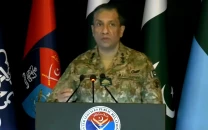Philosophy lectures: The truths and fallacies of the Asiatic mode of production
Discussions focus on pre-industrial age India, its governance, significance of water.

The ninth lecture on modern history and philosophy, that took place in the ATS Centre Blue Area on Friday, focused on the Asiatic mode of production (AMP).
Despite the location change and auditory transmission, the class remained the same. Ashfaq Saleem Mirza delivered the lecture and participants ranging from writers, intellectuals, teachers, students and people generally interested in philosophy, took part in a lively debate and discussion that followed.
Having covered AMP in the first half of the lecture, Mirza delved into etymology of the East (Indian Subcontinent), the origin of the caste system, and the subjectivity of history and geography. AMP refers to a historical era in the Middle East and Asia where the resources of production and irrigation were controlled by the king. In areas where the king was chosen using blood lineage, it was referred to as Oriental Despotism.
Mirza clarified that though AMP is most often associated with Karl Marx in 1859, he in fact was not the pioneer of the idea, which was actually the product of early European travellers to India such as the father of economics, Adam Smith.
Most critics are actually sceptical of Marx’s work on AMP, as he had never visited India. However, travelers such as Smith observed that the king collected revenues through a bureaucracy of villagers who were self-sufficient. Due to their self-sufficiency, the kings’ total control over irrigation and lack of international contact, India remained low on innovation.
For Marx, it is this static nature that defines AMP. Furthermore, it was only when surplus crop was available that commodity exchange occurred that defines Marx’s theory of production: “it is always surplus which becomes a commodity”.
Mirza shared that there are a few theories that propose there was indeed private production in India at the time, and that the source of the king’s power was in fact control of water.
However, a comparative study of Oriental Despotism in Iran at that time reveals that despite Persian kings’ meagre water supply, despotism was strongest there. Two counter arguments were proposed by participants Hans Fry and Quaid-i-Azam University History and Research Prof Akhtar Bodla. Fry argues that though scarce in water, Persia was rich in many valuable materials such as minerals that could be used as a commodity to cement the king’s power. Bodla argued that at that time, Persia’s geography included the Tigris and Euphrates rivers that allowed access to a reliable water supply for the king to control.
Despite the realisations of early writers about AMP, Mirza noted that their first impression likened India’s system to feudal Europe, and it was much later that a further analysis and differentiation occurred.
Therefore, even AMP stands to be a very Eurocentric commentary on India, ignoring some administrative qualities that were present despite the despotic structure.
Mirza shared that during the Reign of Sher Shah Suri and under Akbar’s ‘Ain-e-Akbar’, there were documented records of every district’s revenue matters.
There were about 30 participants, a steep drop from the usual 60-70 at Safma, which might be attributed to the new location being a little tasking to find.
Published in The Express Tribune, March 17th, 2012.



















COMMENTS
Comments are moderated and generally will be posted if they are on-topic and not abusive.
For more information, please see our Comments FAQ